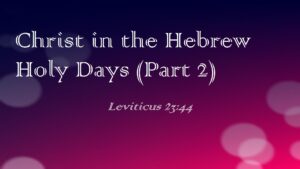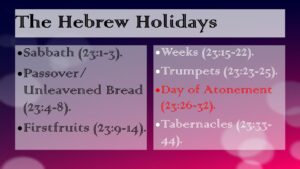Christ in the Hebrew Holy Days (Part 2)
Leviticus 23:44
As we discussed last time, every culture needs to have days that they celebrate collectively.
We have our holidays commemorating certain special events.
The Israelites had them, too, and they were quite appropriate for their agrarian society.
Last week we looked at three of those in Leviticus 23.
Weekly Sabbath, Passover and the Feast of Unleavened Bread, Feast of Firstfruits.
In each of these we saw how Christ fulfills them (Col. 2:16-17).
He is our rest, our Passover Lamb, and the firstfruits of the resurrection.
Today we will consider three more:
Feast of Weeks (23:15-22).
Feast of Trumpets (23:23-25).
Day of Atonement (23:26-32).
Feast of Tabernacles (23:33-44).
We will mention the Day of Atonement, but since we talked about it when we looked at Lev. 16, we will not dwell on it.
Feast of Weeks (23:15-22).
This was closely related to the earlier festivals.
Recall the Feast of the Firstfruits is an offering of the first fruits of the year.
So it began with the barley harvest in the first month of Abib/Nisan.
The second month of Ziv/Iyyar is the month of the wheat harvest.
Near the beginning of the third month of Sivan, we see the Feast of Weeks.
This was a holiday of thanksgiving for the harvests of the two crops that were used in making bread.
This is shown by the two male lambs to be offered as a peace offering—recall an offering of praise and thanksgiving.
Passover, Weeks, and the Day of Atonement were the three holidays all Israelite men were obligated to attend in Jerusalem, or wherever the tabernacle was, throughout the year.
There were four different schools of thought for the timing of this holiday .
As before, they are dependent on how one interprets “Sabbath.”
If one interprets it as the first last day of the week after Passover, then this holiday would always fall on a Sunday.
This is the interpretation that makes the most sense, particularly from a Christian perspective.
Another suggests it was the first last day of the week after the Feast of Unleavened Bread, so a week later.
The Sabbath could be the first day of the Feast of Unleavened Bread, which would make Weeks land on 6 Sivan.
Recall that there was a day of rest on the first day of the Feast of Unleavened Bread, and on the last day.
So if it’s the last day, then that makes Weeks land on 12 Sivan.
As I said, I think the first interpretation is the right one based on what we read in the New Testament for this holiday.
Interesting points.
This is around when the time when Moses was given the Law on Mt. Sinai.
If you recall in the class on the chronology, we established that was sometime in the third month (Exo. 19:1 – 14 Sivan).
This holiday has the dual function of commemorating the end of the grain harvests and honoring the day on which Israel received the Law from God.
One more interesting fact is that this is the only grain sacrifice they were supposed to make that included leaven (23:17).
Here it was a symbol of their bounty and the blessings of God.
Recall that the original purpose of baking unleavened bread in the exodus was so that they wouldn’t have to wait for it to rise, and they could get going quickly.
At Mt. Sinai, they were able to stay for nearly a year while they received this wonderful Law of God through Moses.
In the NT this was also called Pentecost.
It is called this in the LXX as well because of the connection to the number 50.
This leads us to the Day of Pentecost in Acts 2.
All Jewish men were obligated to be in Jerusalem for this celebration, the perfect day for so many to witness the events that were to take place.
This is the day on which the Holy Spirit came down and guided the Apostles into all truth as Jesus had promised (John 16:13).
It was the day the Israelites received the Law of Moses, and it was the day we received the Law of the Spirit of life in Christ Jesus (cf. Rom. 8:2).
At Mt. Sinai, do you remember how many people died after building and worshiping the idol golden calf? It was 3000 (Exo. 32:28).
Now do you remember how many souls obeyed the gospel in Acts 2? Of course, that was 3000 (Acts 2:41) – what perfect symmetry!
Gleanings left (23:22).
Before we leave this section, we see a repeat of a command in Lev. 19:9-10.
That command also references the vineyard, while this one specifies only the grain of the field.
Amid all the thanksgiving being offered, we see a directive not to neglect the poor or the stranger/foreigner.
The poor and the stranger still had to collect the gleanings for themselves, but they were provided for in this system.
Just as they were to remember the poor and the stranger, surely we are, too.
This is particularly true when we remember how many Jews from other places were present in Acts 2 and how poor the church in Jerusalem would become.
Feast of Trumpets (23:23-25).
This feast kicked off the end of the harvest and other celebrations in the fall.
This was on the first day of the seventh month, or 1 Ethanim/Tishri.
In our calendar, this is in September or early October.
Later, it came to be known as a new years celebration.
Their civil calendar was different than their religious calendar.
There is evidence for this with how the years are counted for the kings of Judah.
Not to mention that in modern times, Rosh Hashanah is considered the beginning of the Jewish New Year.
This passage doesn’t say much about this holiday (Num. 29:1-6).
It is simply a day of rest, blowing of trumpets, and a holy assembly (worship) with sacrifices included—Numbers 29 goes into more details on the sacrifices to be offered.
The trumpets and all their uses are later described in Numbers 10:1-10.
They were to be trumpets made of silver, used to direct the camp, as a call to worship, a call to arms, and to commemorate the sacrifices offered.
The trumpet shout often calls to mind the voice of God.
The first mention of a trumpet is in Exo. 19 meant to signal when the people could approach Mt. Sinai, the mountain of God.
This has definite eschatological overtones in the NT era, reminding one of the Last Day, the Day of Judgment.
In fact, the word translated into English is used most often in Revelation.
Specifically it is found in the seven trumpets of Rev. 8-9; 11.
Since the Feast of Trumpets signaled the end of harvest, it would make sense that many would view judgment as a harvest—Jesus’ Parable of the Wheat and the Tares comes to mind (Matt. 13).
In fact, our Lord’s return will be heralded by the sound of trumpets, a sound we eagerly await! (1 Thess. 4:16-17; 1 Cor. 15:51-52).
A Word on the Day of Atonement (Yom Kippur).
This leads us into 10 Tishri, the Day of Atonement.
Recall, this was the day in which all the sins of the nation were to be atoned for.
Christ was not only our Passover Lamb, the one who delivers us from sin, but He is also the atoning sacrifice for all mankind.
On top of that, when He rose from the dead, He became as the scapegoat who removed our sins from us out of the camp, as it were.
Feast of Tabernacles/Booths (23:33-44).
This is another feast of thanksgiving and remembrance.
It is another week-long feast, starting on 15 Tishri lasting until 21st.
It kicks off with a holy convocation and it ends with one on the 22nd.
Two peculiar things are attached to this holiday, however.
Gathering of fruit, branches, boughs, and willows.
And dwelling in booths or tabernacles for a week.
This seems to have been one of the most neglected holidays in Israelite history (Neh. 8:13-18).
This had ceased to be observed since the days of Joshua (Neh. 8:17).
That means this holiday had been neglected for nearly 1000 years!
No wonder the Israelites were so forgetful of their heritage!
We note that the gathering of the plants was meant to be used to construct the booths they were to live in for the festival (Neh. 8:15).
Incidentally, this is a great biblical example of following a generic command left up to one’s judgment (Neh. 8:16) – there was no command of where to place the booths, so placement was up to them.
Dwelt in booths for a week.
Have you ever gone camping before? How about setting up a tent in your backyard and camping there?
That’s essentially what the Jews did in Nehemiah’s time, and that’s what the Israelites had neglected for nearly a millennium.
And we see why they were to do this: to remind them of what it was like for their ancestors to live in the wilderness.
Of course, the Israelites at this point didn’t know they’d be spending 40 years out here, but it was meant to remind their descendants of the hardship they went through out there.
In the time of harvest, when they had the most they would have that year, this was meant to remind them to be thankful to the Lord for what they have now.
They were to deny themselves for a week of many of the comforts of home.
This also would remind them that, just as God took care of their ancestors, He would take care of them as well—if they were to be faithful.
NT Application.
We should always remember how truly dependent we are upon God.
The Israelites often thought they did things on their own, and we are no different.
We may not live in booths for one week out of the year, but we do live in an earthly tent every day of our lives (2 Cor. 5:1-8).
Paul reminds us that our bodies are merely tents, housing that which is most important—our souls.
While we are in that earthly tent, it’s not unlikely being in the wilderness.
We had escaped the bondage of sin just as they escaped bondage in Egypt.
They were baptized in the baptism of Moses when they crossed that Red Sea (1 Cor. 10:2) just as we were baptized in the baptism of Christ when we were delivered.
So now we wonder, potentially for decades, under God’s guidance and protection, until we finally reach the Promised Land, for us that land of eternal rest in heaven.
You see, when we shed this earthly tent, if we have proven faithful to Him, we will have an eternal home in heaven with our Lord.
Our tents may be made with the most wonderful branches, but no matter how great they are, they are but temporary.
And in that home in heaven, we will be present with the Lord for all time.
What an amazing and wonderful promise!
Conclusion.
So, considering Christ in all of these holidays.
Sabbath – only in Him can we find true rest.
Passover – He is our Passover Lamb, our Deliverer.
Firstfruits – He is the first to have risen from the dead, a promise of our future resurrection.
Weeks – He sent the Spirit down to establish His church.
Trumpets – one day He is coming back again with a trumpet shout.
Day of Atonement – He is our high priest, atoning sacrifice, and scapegoat all in one.
Tabernacles – a promised hope of being in heaven with Him.
Recall, all these are merely a shadow of the reality.
That reality is Christ (Col. 2:16-17).
He really does fulfill the whole Law.
Wouldn’t you like to be able to take full advantage of our Lord and the blessings He freely offers everyone who wants it?

